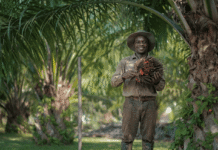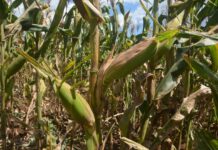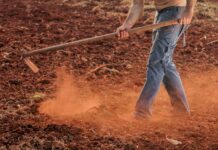By: Dr Kobus Du Plessis
Irrigation agriculture is the largest consumer of water in South Africa as it uses approximately 62% of the total national water supply. At present, a million hectares from a potential 1,4 million hectares of land is under irrigation. Large volumes of water are transported through irrigation canal systems to water crops to supply food to the nation. All water conveyance structures experience water loss, and irrigation canals are definitely no exception. As agriculture is the main water user and the sector with the highest potential to save water, it makes sense that savings in water loss in the agricultural sector will make the biggest impact on overall water loss control in South Africa.
South Africa has thousands of kilometres of canals criss-crossing the countryside from which the majority of the irrigation schemes receive their water supply. These canals are both lined and earthen structures.
Many of these water conveyance structures are plagued by the proliferation of nuisance aquatic vegetation, such as filamentous algae and submersed aquatic macrophytes. Following the winter months, the increasing day length and consequent rise in ambient temperatures result in increased water temperature and light penetration into dams and canals. During the summer season optimum environmental conditions and the presence of sufficient plant nutrients (phosphates and nitrates) lead to an explosion in aquatic vegetation biomass on affected irrigation canal systems.
Envirokonsult Scientific Services (Pty) Ltd managing director, Dr Kobus Du Plessis, who has studied this phenomenon over the years, reports that aquatic vegetation, proliferate in a relatively short period to form dense masses of organic material that result in substantial operational problems with economic implications in water supply systems and waste significant volumes of water. “Large volumes of the design capacity of canals and other water conveyance structures are displaced by the exponential increase in plant biomass. This leads to spillage, water loss and failure of civil structures.”
It is estimated that a minimum average of 20% to 30% of the water supplied to the irrigation sector is lost due to leakages out of conveyance structures, evaporation, evapo-transpiration, spillage and flooding, among others. Some older schemes have, and still are, recording periodic losses of more than 50% on certain canals. Where water is released into rivers for irrigation downstream, water loss can easily reach 50% of the volume released (a part of this water is however essential for provision for the Reserve – aquatic ecosystem).
As aquatic vegetation contributes significantly to water loss from water conveyance structures the problem is also addressed by the Department of Water and Sanitation’s Water Conservation and Water Demand Management Strategy (WC/WDS). “Based on current agricultural tariffs, a mere 10% saving in the current water loss (taken as 25% of usage by the agricultural sector), can result in savings of at least R120-million per annum (savings on crop losses not included) and release more than 550 million m3/a of water for use by other sectors,” notes Du Plessis.
OPERATIONAL PROBLEMS
Aquatic vegetation cause a host of operational problems in water conveyance structures, such as reducing hydraulic capacity and flow speed in affected canals – some to such a degree that the supplied water cannot reach the terminal point of the canal system. Aquatic vegetation can replace significant volumes of the capacity of a canal. This results in spillage and water loss out of the system, as well as crop losses due to under-supply of water to irrigators.
Another operational problem is that of over-estimation of the volume of water supplied to the user. As aquatic vegetation biomass replaces water in a canal, a higher volume of water is measured at measuring devices at what is in fact passing at that specific location. The overestimation of flow makes the optimal operation of water supply a difficult task as less water is passing at a specific point as what is measured. To compensate for these artificially high water levels, more water is often released into the system, giving rise to flooding with subsequent water loss and damage to canal infrastructure.
Other problems with the presence of aquatic vegetation in canal systems include impediment of sluice gates working at dividing structures, water logging of long-weirs, structure failure of concrete-lined irrigation canals due to flooding, and blocking of irrigation systems and filters at water purification works by aquatic vegetation fragments.
CONTROLING AQUATIC VEGETATION IN CANAL SYSTEMS
Historically, aquatic vegetation control measures applied in South Africa have been symptomatically orientated. The problem was treated only once it visibly influences the operation of the system. Different control options have been investigated over the years and implemented with varying levels of success. As the majority of South African canals are in operation 365 days per year, one of the greatest challenges was finding a control option that takes the canal out of operation for as short a time as possible.
In the past, the mechanical removal of the aquatic plant biomass from the canals had been a popular method; however, it was expensive, labour intensive and time consuming. It has also been found that in peak summer months the bio-mass cannot be removed efficiently and fast enough. Long dry periods to do mechanical cleaning and maintenance was found to be unproductive. “To date, attempts to control the biomass mechanically in systems that continuously supply water seem to be relatively unsuccessful and uneconomic,” says Du Plessis.
In terms of chemical control methods the so-called ‘lower pH-method’ has been favoured in the 1980’s and 1990’s using copper sulphate after lowering the pH of the water with sulphuric acid. In those years local herbicidal options were limited to the treatment of aquatic vegetation with herbicides/algaecides with mainly copper and diquat as active ingredient. Unfortunately, both substances have their limitations under local conditions. The copper products are more effective on algae than on submersed macrophytes, while the diquat-based product is on the other hand more effective on macrophytes than algae. Other algaecides and herbicides with heavy metals as active ingredient were also tested over the years. But the problems associated with these products were many as their usage resulted in the build up of toxic residues in irrigation soils, were corrosive to canal infrastructure and irrigation equipment and necessitated downtime for the canals as well as withholding periods from crops.
An alternative herbicide, with the trade name of MAGNACIDE™ H Herbicide (L8655), has recently been introduced to the South African market from the United States. “This water-soluble aldehyde, which comes in liquid form and has acrolein as its active ingredient, can be used in operational water conveyance systems without interrupting irrigation water deliveries, and is characterised by superior effectiveness and quick dissipation without any residue,“ reports Du Plessis. “What makes acrolein a good prospective is that the product does not accumulate in crops, soil or groundwater and can be applied directly to crops. Further-more, acrolein (an organic molecule) dissipates to harmless carbon dioxide (CO2) and water (H2O) as end products, which makes it more environmentally friendly.” It is also effective on both algae and submersed macrophytes and is used widely in the United States, Australia, Canada, and other countries with similar problems.
Scientific trials with MAGNACIDE™ H Herbicide (L8655) have been completed successfully in Roodeplaat and Hartbeespoort canal systems. In the case of Hartbeespoort water losses was cut by 17% and the water saved could be made available to new mines in the area which are expected to inject more than R1-billion into the local economy – something that would have been difficult without the available water. Even better results were obtained in the Roodeplaat canal system, North of Pretoria, were water losses were cut by 19% with ad hoc treatments of the canal with MAGNACIDE™ H Herbicide (L8655).
It was found that MAGNACIDE™ H Herbicide (L8655) provides excellent control of both vascular submersed aquatic vegetation and algae providing more effective results than any other control method. A single application generally restores canal flow capacity within 24 hours after application; nuisance vegetation disintegrates over a 5 to 10 day period. The product has no effect on civil canal structures and is not corrosive to irrigation equipment.
Preventative maintenance plans are now implemented on local irrigation canal systems to control aquatic vegetation to levels were they cannot cause operational problems and canals will not spill as a result of biomass infestations. Integrated Aquatic Vegetation Management Plans (IAVMP’s) are developed and implemented for each irrigation scheme with MAGNACIDE™ H Herbicide (L8655) as chemical control component on the flowing canal water and sterile Chinese grass carp (Ctenopharyngodon idella) as biological control component in balancing dams, irrigation dams and other semi stationary impoundments on the irrigation scheme.
The introduction of sterile Chinese grass carp to combat aquatic vegetation in dam structures, both in the water conveyance structures and in on-land irrigation dams is very successful. The combination of the herbicidal control method with the bio-control agent has made aquatic vegetation problems in irrigation canal systems something of the past.
A preventative maintenance programme consists of a series of herbicidal applications to canals with MAGNACIDE™ H Herbicide (L8655) at a scheduled frequency, whilst sterile grass carp is stocked in dams. With a preventative maintenance IAVMP in place, the irrigation scheme manager can keep his water distribution system in an optimal operational condition with minimal disruption of water delivery and maximum water savings.
Dr Kobus Du Plessis : is a professional water scientist with 30 years of experience in the water sector. He is the managing director of Envirokonsult Scientific Services (Pty) Ltd, based in Hartbeespoort, North West Province. He specializes in water resource management, integrated aquatic vegetation management programmes, water loss control, urban lake management and irrigation canal maintenance programmes.








